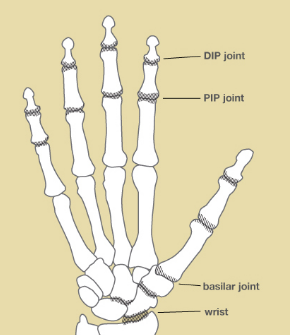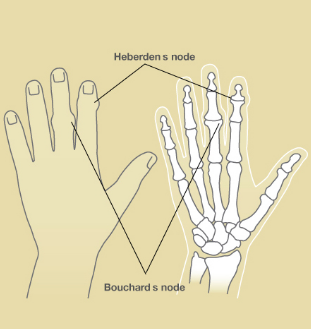Osteoarthritis of the Hands
Arthritis— which literally means“inflamed joint” — can affect any joint in the body, including the joints between the 29 bones of the wrist, hand, and fingers. Arthritis of the hand can hurt and keep you from being able to do what you want or need to do. The most common forms of arthritis in the hand are osteoarthritis, post-traumatic arthritis (after an injury), and rheumatoid arthritis. Osteoarthritis is a degenerative joint disease in which the smooth cartilage that covers the bone surfaces at the joints either is injured or wears over time.
Causes
A normal joint is made of two smooth, cartilage-covered bone surfaces that fit well together so that they glide when the bones move. If the smooth surfaces wear out, then they no longer fit together and arthritis develops. Injury, infection, gout, psoriasis, and other conditions can also cause arthritis of the hand.
Signs and Symptoms

The three most common sites where arthritis happens in the hand are (see Figure 1):
- At the base of the thumb, where the thumb and wrist come together (the trapeziometacarpal or basilar joint)
- At the joint closest to the fingertip (the distal interphalangeal or DIP joint)
- At the middle joint of a finger (the proximal interphalangeal or PIP joint)
All forms of hand arthritis can cause stiffness, swelling, pain, and deformity. Osteoarthritis sometimes causes bony nodules at the middle joint of the finger (Bouchard’s nodes) or at the end joint of the finger (Heberden’s nodes) (see Figure 2). Osteoarthritis at the basilar joint can cause swelling, a bump, and a deep, aching pain at the base of the thumb. Weakness of grip and pinch can make it hard to open a jar or turn a key for those with osteoarthritis.

Diagnosis
When diagnosing osteoarthritis, your doctor will ask you about your hands and other joints. Explain how your symptoms affect what you do. Your doctor will check how your hands look and function. X-rays of joints with osteoarthritis can show loss of normal joint space, “bone spurs,” or other changes.
Treatment
The goals in treating osteoarthritis are to relieve pain and restore function. Brief rest — either by changing activities or wearing a splint — can help. Soft, snug sleeves can help support a joint when rigid splints are too restrictive. Heat (for example, paraffin wax and warm compresses) can soothe the joints and help keep them mobile. It is important to keep as much finger motion and function as possible. Hand therapists can teach joint protection exercises and activity modification to help protect joints. Anti-inflammatory medication or a steroid injection into the joint can decrease pain, but neither cures osteoarthritis.
Surgery is considered when the non-surgical options above have not helped. In most cases, you will tell your doctor when you are ready for surgery. The goal is to restore as much function as possible and to minimize your pain. One type of surgery is joint fusion. The worn cartilage is removed and the bones on each side of the joint are fused together, which means that the joint will not move but it will not hurt. Another choice is joint reconstruction, where the rough joint surface is removed and either replaced with your own soft tissue or with an implant. The type of surgery depends on the joint(s) involved, your anatomy, and your activities. Your hand surgeon can help you decide which type of surgery is the best for you.
